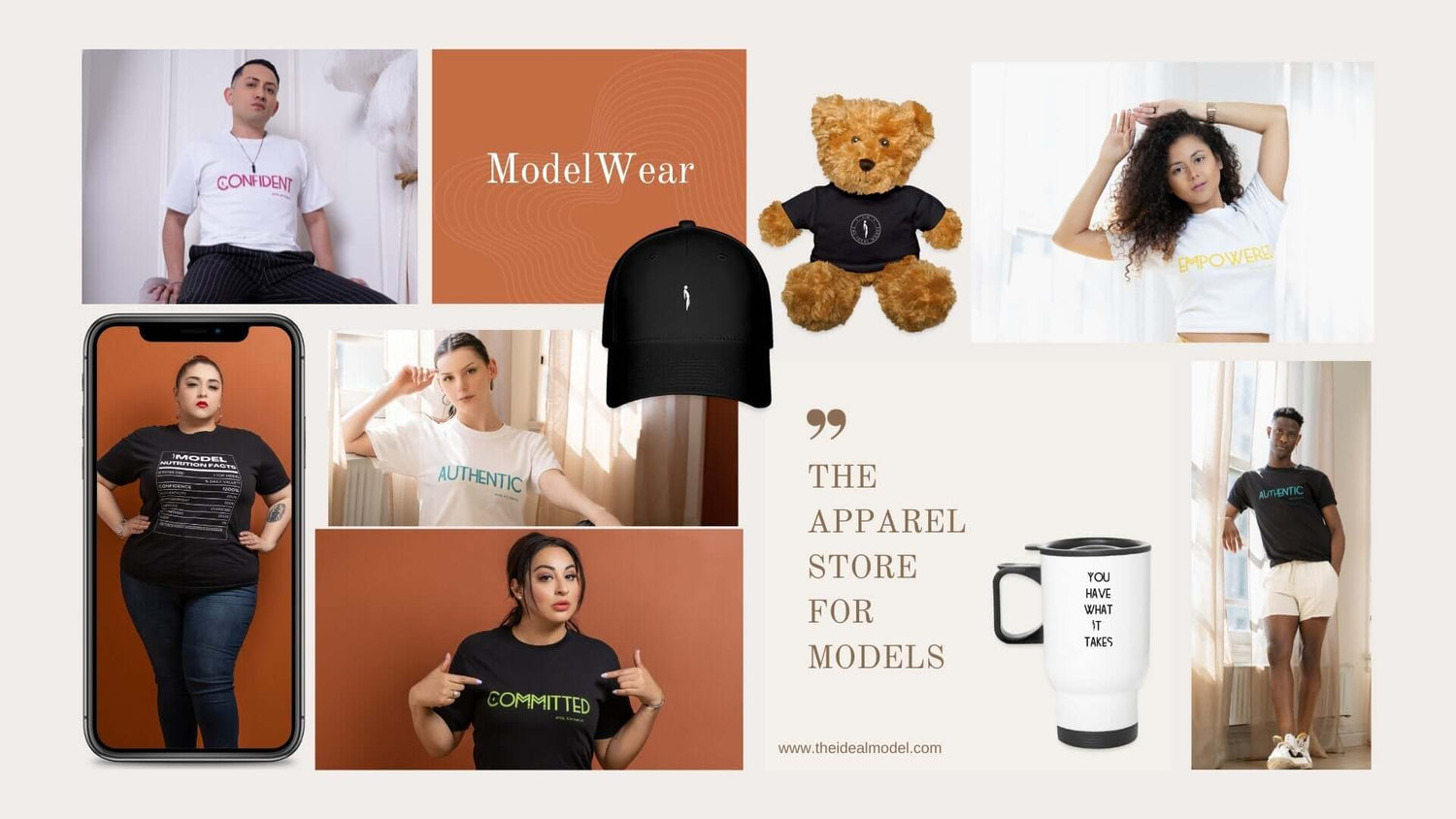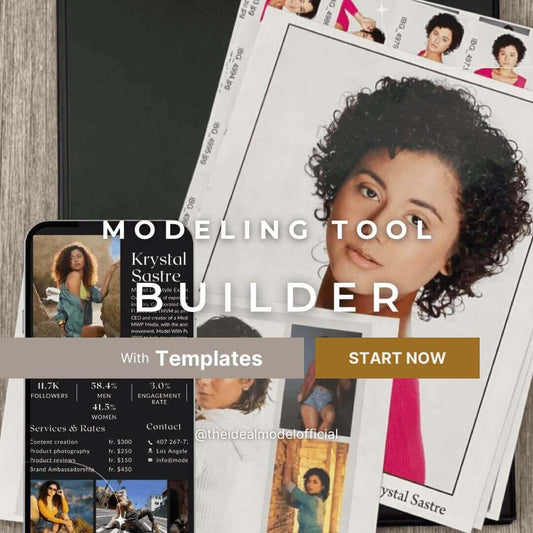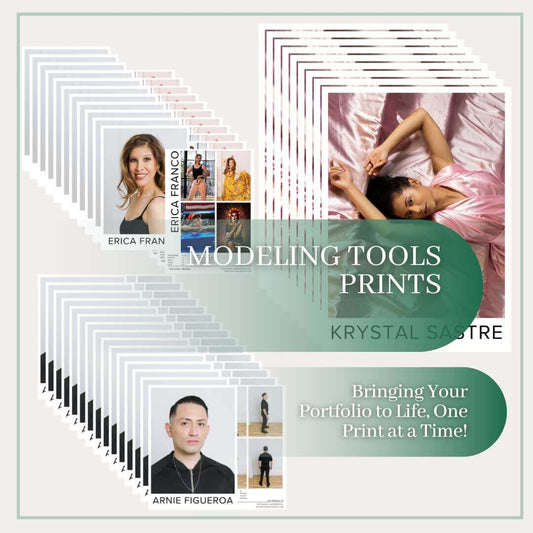As I reflect on my own modeling journey, I'm reminded of the excitement and uncertainty that comes with taking those first steps into the industry. From navigating casting calls to perfecting my runway walk, each experience has shaped me into the model I am today.
In this article, I'll share seven essential tips to help kickstart your own modeling journey, drawing from my personal anecdotes and insights gained along the way.
Step 1: Define Your Goals
Before diving into the world of modeling, it's essential to define your goals and aspirations. Understanding what you hope to achieve in your modeling career will guide your actions and help you stay focused as you embark on your journey. Below are different types of modeling and their niches to consider when setting your goals:
1. Fashion Modeling
- Body Type: Tall and slender with well-proportioned measurements.
- Age Range: Typically ranges from late teens to mid-20s.
- Personality: Confident, adaptable, and versatile.
- Demand: High demand in the fashion industry, especially for runway and editorial work.
- Competition: Intense competition, with many aspiring models vying for limited spots.
- Difficulty Level: High. Requires exceptional height, proportions, and runway skills.
2. Commercial Modeling
- Body Type: Varied body types, including petite, plus-size, and average.
- Age Range: All ages, from children to seniors.
- Personality: Approachable, relatable, and expressive.
- Demand: Wide range of opportunities in advertising, catalogs, and commercials.
- Competition: Moderate competition, with opportunities for models of all shapes, sizes, and ages.
- Difficulty Level: Moderate. Requires versatility and the ability to convey a range of emotions and characters.
3. Fitness Modeling:
- Body Type: Fit, toned, and athletic physique.
- Age Range: Primarily young adults to middle-aged individuals.
- Personality: Energetic, disciplined, and health-conscious.
- Demand: Growing demand in the health and wellness industry, including fitness magazines, advertisements, and social media.
- Competition: Moderate competition, with opportunities for models with a strong fitness background.
- Difficulty Level: Moderate. Requires dedication to fitness and maintaining a healthy lifestyle.
4. Glamour Modeling:
- Body Type: Curvaceous with emphasis on curves and body confidence.
- Age Range: Primarily young adults to middle-aged individuals.
- Personality: Confident, sensual, and comfortable in front of the camera.
- Demand: Demand in the entertainment industry, including magazines, calendars, and online platforms.
- Competition: Moderate competition, with opportunities for models with a striking and photogenic appearance.
- Difficulty Level: Moderate. Requires confidence and comfort with posing in revealing or suggestive attire.
5. Editorial Modeling:
- Body Type: Varied body types, depending on the publication's aesthetic.
- Age Range: Typically ranges from late teens to mid-20s.
- Personality: Creative, expressive, and fashion-forward.
- Demand: Demand in high-fashion publications and magazines for artistic and avant-garde shoots.
- Competition: High competition, with opportunities for models with unique and striking features.
- Difficulty Level: High. Requires versatility, creativity, and the ability to embody different editorial concepts.
Assignment:
Now that you're familiar with the different types of modeling and their niches, take some time to create a goal list for your modeling career. Consider your strengths, preferences, and aspirations, and outline specific goals you hope to achieve in each area. Remember to be realistic and flexible in your goal-setting process. Your goals will serve as a roadmap to guide you on your modeling journey.
Step 2: Build Your Portfolio
Your portfolio serves as your visual resume in the modeling industry—a showcase of your talent, versatility, and potential. It's the first impression you'll make on potential clients and agencies, so it's essential to invest in creating a portfolio that stands out. Here's how to build a compelling portfolio:
1. Professional Photoshoots:
Invest in professional photoshoots to capture high-quality images that highlight your unique features and modeling skills. Work with experienced photographers who understand how to showcase you in the best light. Choose a variety of settings, backgrounds, and lighting to demonstrate your versatility as a model.
2. Variety of Looks, Poses, and Expressions:
Your portfolio should showcase your range as a model, so include a variety of looks, poses, and expressions. Experiment with different styles, from high fashion to commercial, and convey a range of emotions and characters. Show potential clients and agencies that you're adaptable and can bring their vision to life.
3. Update Regularly:
As you gain more experience and expand your skill set, it's important to update your portfolio regularly. Replace older images with new ones that reflect your growth and evolution as a model. Keep your portfolio fresh and relevant to demonstrate your ongoing commitment to your craft.
Now, let's talk about modeling tools that can enhance your portfolio and streamline your modeling career:
- Comp Card (Composite Card):
A comp card is a versatile marketing tool that contains a selection of your best images, along with your vital statistics and contact information. It's often used by models to leave a lasting impression on potential clients and agencies during castings and networking events.
- Digitals (Polaroids or Snapshots):
Digitals are simple, unretouched photographs that showcase your natural beauty and physique. They provide clients and agencies with an accurate representation of how you look without makeup or styling. Digitals are essential for submitting to agencies and booking castings remotely.
- Modeling Resume:
Your modeling resume highlights your professional experience, skills, and accomplishments as a model. Include details such as your height, measurements, runway experience, and any notable clients or publications you've worked with. A well-crafted modeling resume can help you stand out from the competition and secure bookings.
- Media Kit:
A media kit is a comprehensive package that includes your portfolio, comp card, digitals, modeling resume, and any additional promotional materials. It's often used by models to present themselves to potential clients, agencies, and collaborators in a professional and organized manner.
Consider utilizing the ModelTool Template Builder to create your comp card, digitals, modeling resume, or media kit. This user-friendly tool offers customizable templates and design options to help you create professional-looking materials that showcase your unique style and personality. Building your modeling toolkit with these essential tools will enhance your portfolio and elevate your modeling career to new heights.
Step 3: Research Agencies and Markets
Research is an indispensable part of navigating the modeling industry successfully. Take the time to delve into the landscape of modeling agencies and the markets they serve. Here's how to effectively conduct your research:
1. Identify Reputable Agencies:
Start by compiling a list of modeling agencies in your area or those that represent models with similar characteristics to yours. Look for agencies with a strong reputation in the industry and a track record of success.
2. Consider Specializations:
Each modeling agency may specialize in specific markets or types of modeling. Consider factors such as their client roster, the types of projects they handle, and the markets they serve. Choose agencies that align with your career goals and aspirations.
3. Evaluate Reputation and Track Record:
Research the reputation of each agency by reading reviews, testimonials, and industry publications. Look for agencies known for their professionalism, integrity, and ability to secure lucrative opportunities for their models.
4. Assess Client Roster:
Take a close look at the agency's client roster to gauge the types of clients they work with and the caliber of projects they handle. A diverse client portfolio indicates that the agency has connections across various industries and can provide a range of opportunities for its models.
5. Tailor Your Submissions:
Once you've narrowed down your list of potential agencies, tailor your submissions to each agency accordingly. Customize your portfolio, composite cards, and cover letter to showcase your strengths and align with the agency's aesthetic and clientele.
6. Utilize Resources:
As a helpful resource for your research, consider using platforms like models.com. With its extensive database and editorial content, models.com provides valuable insights into the industry, connects talent with agencies, and highlights emerging trends and creatives shaping the fashion world.
By conducting thorough research and strategically targeting agencies that align with your goals, you'll increase your chances of finding representation and unlocking exciting opportunities in the modeling industry. Remember, knowledge is power, so arm yourself with information to make informed decisions about your modeling career.
Step 4: Attend Open Calls and Casting Calls
Open calls and casting calls serve as valuable opportunities for models to present themselves to potential clients and casting directors. Here's how to make the most of these events:
1. Stay Informed:
Keep an eye out for upcoming casting calls in your area by following local modeling groups on social media platforms like Facebook, browsing event listings on platforms like Eventbrite, or staying updated with announcements on our Instagram channel. Always verify the legitimacy of the casting call before attending.
2. Safety First:
Prioritize your safety when attending open calls and casting calls. Consider bringing a trusted friend or family member with you, or share your location with a loved one. Trust your instincts and avoid attending events in unfamiliar or unsafe locations.
3. Attend Multiple Events:
Take advantage of as many open calls and casting calls as you can. Each event presents a unique opportunity to showcase your talent and personality to industry professionals. Attend a variety of events to maximize your exposure and increase your chances of securing opportunities.
4. Practice Your Craft:
Before attending an open call or casting call, practice your runway walk, poses, and expressions to perfection. Confidence is key, so focus on exuding confidence and professionalism in front of the camera and casting directors.
5. Come Prepared:
Ensure you're well-prepared for the event by bringing essential items such as your portfolio, composite cards, and any required documents or paperwork. Your portfolio should showcase your versatility and range as a model, so include a variety of looks and styles to leave a lasting impression.
6. Make a Lasting Impression:
When attending open calls and casting calls, strive to make a lasting impression on casting directors and clients. Be punctual, courteous, and professional at all times. Demonstrate your enthusiasm and passion for modeling, and showcase your unique personality and charm.
By actively participating in open calls and casting calls, you'll increase your visibility in the industry, forge valuable connections, and pave the way for exciting opportunities in your modeling career. Remember to stay persistent, patient, and proactive in pursuing your dreams.
Step 5: Network, Network, Network
Networking is a cornerstone of success in the modeling industry. Here's how to harness the power of networking to propel your career forward:
1. Attend Industry Events:
Make it a priority to attend industry events such as fashion shows, runway events, and industry mixers. These events provide valuable opportunities to connect with industry professionals, including photographers, designers, and casting directors.
2. Engage on Social Media:
Utilize social media platforms like Instagram, LinkedIn, and Twitter to network with industry professionals and fellow models. Follow influential figures in the industry, engage with their content, and participate in relevant conversations.
3. Build Genuine Relationships:
Focus on building genuine relationships with industry professionals based on mutual respect and trust. Take the time to get to know people on a personal level, and show genuine interest in their work and achievements.
4. Collaborate on Projects:
Look for opportunities to collaborate on creative projects with photographers, makeup artists, stylists, and other industry professionals. Collaborative projects not only enhance your portfolio but also strengthen your professional relationships.
5. Attend Networking Mixers:
Keep an eye out for networking mixers and events specifically geared towards models and industry professionals. These events provide a relaxed and informal setting to connect with like-minded individuals and expand your network.
6. Follow Up and Stay Connected:
After networking events or collaborations, don't forget to follow up with the people you've met. Send personalized thank-you notes or emails expressing your appreciation for the connection and expressing interest in future collaborations.
7. Offer Value and Support:
Be generous with your time, expertise, and support towards your network. Offer assistance, advice, or mentorship to fellow models and industry professionals when appropriate. Building a reputation as a supportive and helpful individual can strengthen your network and open doors to new opportunities.
Remember, networking is a long-term investment in your career. By actively participating in networking opportunities and nurturing genuine relationships within the industry, you'll position yourself for success and unlock exciting opportunities along your modeling journey.
Step 6: Stay Persistent and Resilient
In the fiercely competitive world of modeling, rejection is an inevitable part of the journey. However, it's how you respond to setbacks that ultimately defines your success. Here's how to stay persistent and resilient in the face of challenges:
1. Embrace Rejection as Growth:
Rather than letting rejection discourage you, use it as an opportunity for growth and self-improvement. Every rejection is a chance to learn and refine your skills as a model.
2. Find Inspiration in Resilient Models:
Many top models have faced numerous rejections before achieving success. Take inspiration from models like Gisele Bündchen, who was initially rejected by numerous agencies before becoming one of the highest-paid models in the world. Their stories serve as a reminder that resilience and perseverance are key to overcoming obstacles in the industry.
3. Maintain a Positive Mindset:
Cultivate a positive mindset and focus on the progress you've made rather than dwelling on setbacks. Celebrate your achievements, no matter how small, and remind yourself of your worth as a model.
4. Seek Support from Your Network:
Lean on your network of friends, family, and fellow models for support during challenging times. Surround yourself with people who believe in your potential and can provide encouragement and guidance when needed.
5. Set Realistic Expectations:
Understand that success in modeling takes time and perseverance. Set realistic expectations for yourself and acknowledge that progress may be gradual. Stay committed to your goals, but also be flexible and adaptable in your approach.
6. Stay Persistent in Pursuing Opportunities:
Don't let setbacks deter you from pursuing opportunities in the industry. Continue to attend castings, submit your portfolio to agencies, and seek out new opportunities to showcase your talent. Persistence is key to breaking through barriers and achieving your goals.
7. Celebrate Your Resilience:
Recognize and celebrate your resilience in the face of adversity. Each rejection you overcome makes you stronger and more resilient as a model. Take pride in your ability to persevere and keep pushing forward towards your dreams.
Remember, success in modeling is not determined by the number of rejections you face, but by your ability to bounce back stronger each time. Stay persistent, stay resilient, and never lose sight of your passion for modeling. With dedication, hard work, and perseverance, you'll be well on your way to achieving your goals in the industry.
Step 7: Stay True to Yourself
In an industry that sometimes prioritizes conformity, embracing your authenticity is your greatest strength as a model. Here's why staying true to yourself is essential:
1. Embrace Your Uniqueness:
Celebrate what makes you unique, whether it's your distinctive features, quirks, or personal style. Your individuality is what sets you apart from other models and makes you memorable to clients and audiences.
2. Showcase Your Personality:
Don't shy away from expressing your personality and authenticity in your work. Whether it's through your poses, expressions, or interactions on set, let your true self shine through. Clients and audiences are drawn to models who exude confidence and authenticity.
3. Stand Out from the Crowd:
By embracing your true self, you automatically stand out from the crowd. Clients are always looking for models who bring something fresh and unique to the table, so don't be afraid to let your personality and authenticity shine through in your portfolio and on the runway.
4. Build Genuine Connections:
Authenticity fosters genuine connections with clients, photographers, and fellow models. People are drawn to those who are genuine and authentic, and these connections can lead to lasting relationships and future opportunities in the industry.
5. Confidence is Key:
Confidence in who you are and what you bring to the table will radiate through your photos and on the runway. Embrace your strengths, embrace your flaws, and carry yourself with confidence in every aspect of your modeling career.
6. Inspire Others:
By staying true to yourself, you inspire others to do the same. Your authenticity can empower fellow models to embrace their uniqueness and confidently pursue their dreams in the industry.
Remember, your authenticity is your greatest asset as a model. Embrace who you are, showcase your personality, and let your true self shine through in every aspect of your modeling career. When you stay true to yourself, you not only stand out in a crowd but also leave a lasting impression on everyone you encounter.
I hope these seven tips serve as a roadmap to guide you on your modeling journey. Remember, success in modeling is not just about your looks—it's about your attitude, professionalism, and willingness to learn and grow. Embrace the challenges, celebrate the victories, and never stop believing in yourself. If you have any questions or would like to share your own experiences, feel free to comment below. I'd love to hear from you!





